This article introduces the paper "Numerical determination of process parameters for fabrication of automotive component" presented at the Conference Tools for Materials Science & Technology (MSE 2010)
1. Overview:
- Title: Numerical determination of process parameters for fabrication of automotive component
- Author: Mohammad Sadeghi, Jafar Mahmoudi
- Publication Year: 2010
- Publishing Journal/Academic Society: Conference Tools for Materials Science & Technology (MSE 2010)
- Keywords: High pressures die casting, process parameters, defect, Al alloy, ProCast
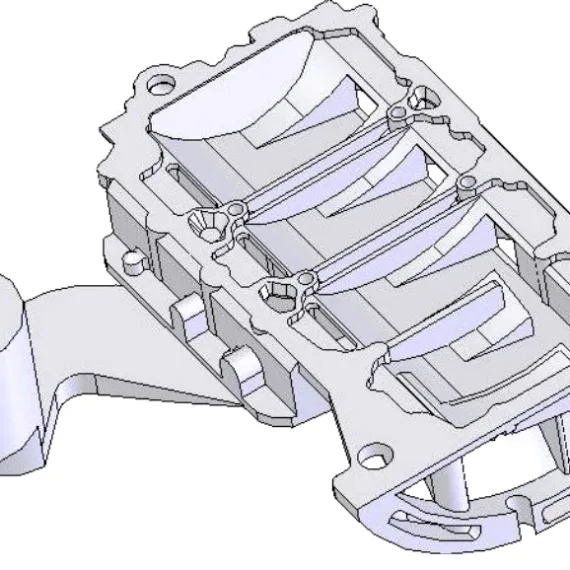
2. Research Background:
- Social/Academic Context of the Research Topic: Casting defects such as cold shut formation, air and gas entrapment, and inclusions are inherent challenges in die casting. Traditionally, controlling these defects has relied heavily on the experience of foundry engineers. Cooling rate is recognized as a significant factor influencing the formation of casting defects.
- Limitations of Existing Research: Existing methods for gating system design and process parameter optimization in die casting often depend on individual knowledge and trial-and-error practices. While recommendations based on geometry and specifications exist, a more systematic and optimized approach is needed.
- Necessity of the Research: Numerical simulation offers a powerful tool to analyze physical phenomena in casting processes, providing insights into fluid flow, heat transfer, and solidification that are not easily observable in real-world casting. This research aims to utilize computer simulations to optimize die casting parameters, reduce scrap, minimize energy consumption, and enhance casting quality.
3. Research Purpose and Research Questions:
- Research Purpose: The primary purpose of this research is to analyze the flow of molten metal and the impact of die temperature on the cooling rate and subsequent casting defects in the high-pressure die casting (HPDC) process. The study focuses on an Iranian automotive component to determine the optimal die temperature for minimizing defects.
- Key Research Questions:
- What is the optimal die temperature for die casting to minimize casting defects in the studied automotive component?
- How does varying die temperature affect the molten metal flow patterns and cooling rate during the die casting process?
- Research Hypotheses: The research implicitly hypothesizes that die temperature is a critical process parameter that significantly influences the formation of casting defects in HPDC, and that numerical simulation can effectively identify optimal die temperature ranges.
4. Research Methodology
- Research Design: This research employs a combined approach of numerical simulation and experimental validation.
- Data Collection Method:
- Simulation: Finite Element (FE) method-based ProCast software was used to simulate the die casting process. Three die temperatures (15°C, 20°C, and 25°C) were simulated while keeping other parameters constant. Material properties for A380 aluminum alloy were used from the software database.
- Experiment: An IDRA1600 die-casting machine was used for injecting molten metal. Filling time was measured using a stopwatch. Solidification time was determined by knocking out molds at different times. Die temperature was measured using a Minolta/Land Cyclops 152 infrared pyrometer before pouring. Castings were cut transversely to analyze shrinkage.
- Analysis Method: The simulation results were compared with experimental observations to validate the model. The analysis focused on flow patterns, temperature distribution, predicted defect locations from simulation, and observed defects in experimental castings.
- Research Subjects and Scope: The research focused on an automotive component named "Ladder frame" made of A380 aluminum alloy (Fig. 1). The study investigated the effect of die temperature on casting defects in this specific component using high-pressure die casting.
5. Main Research Results:
- Key Research Results: The study found that die temperatures between 20°C to 25°C are suitable for die casting the automotive component. A die temperature of 15°C was found to be inadequate.
- Statistical/Qualitative Analysis Results:
- Filling Time: The predicted filling time from simulation was approximately 0.12s, which was in agreement with experimental observations.
- Defect Prediction: Simulations at 15°C die temperature indicated that the melt temperature falls near the liquidus temperature at the final filling position, potentially leading to cold shots and poor filling (Fig. 3). Experimental results validated this prediction, with casting defects observed in these areas at 15°C die temperature (Fig. 3, Fig. 6).
- Solidification Pattern: Simulation showed solidification starts in the center of the part due to thinner sections and progresses outwards. This pattern was consistent with porosity formation observed in the outer side of the casting in experiments (Fig. 5, Fig. 6).
- Data Interpretation: Lower die temperature (15°C) leads to a significant drop in melt temperature, increasing the risk of cold shots and incomplete filling. Higher die temperatures (20°C and 25°C) maintain melt fluidity for longer, improving filling and reducing defects.
- Figure Name List:
- Fig. 1: Geometry of Ladder frame part used for simulation
- Fig. 2: filling pattern
- Fig. 3: final filling position
- Fig. 4: entrapment of air site in the first stage of filling in the runner
- Fig. 5: Solidification patterns
- Fig. 6: final solidification positions
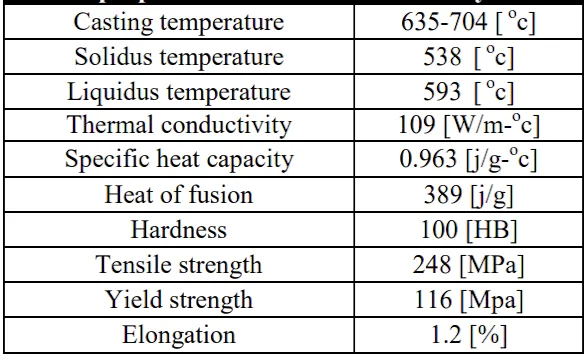
![Table 2: chemical composition of A380
aluminum alloy [wt. %]](https://castman.co.kr/wp-content/uploads/image-289-png.webp)
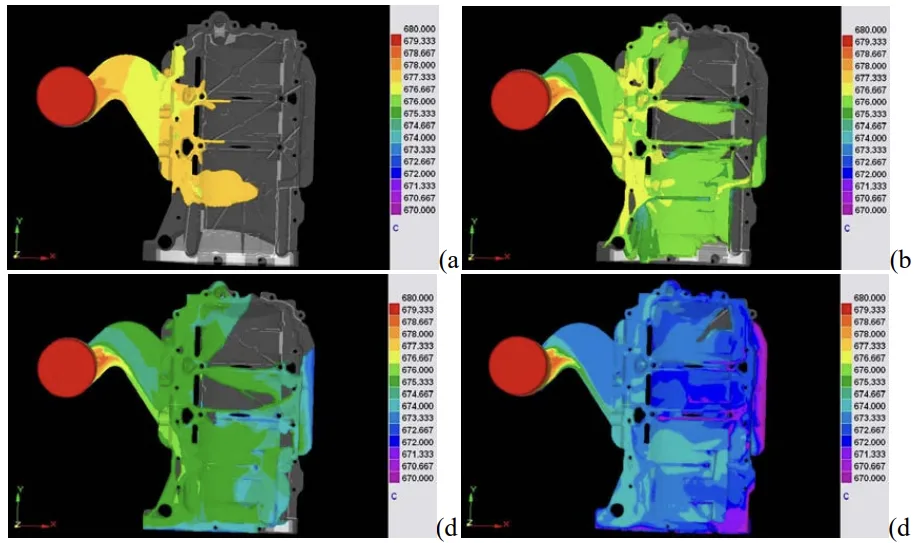
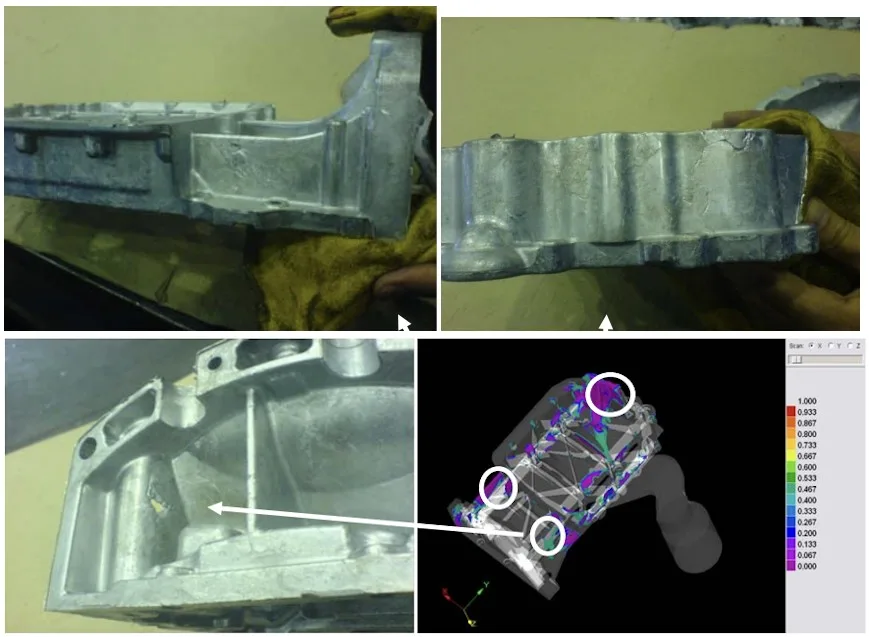
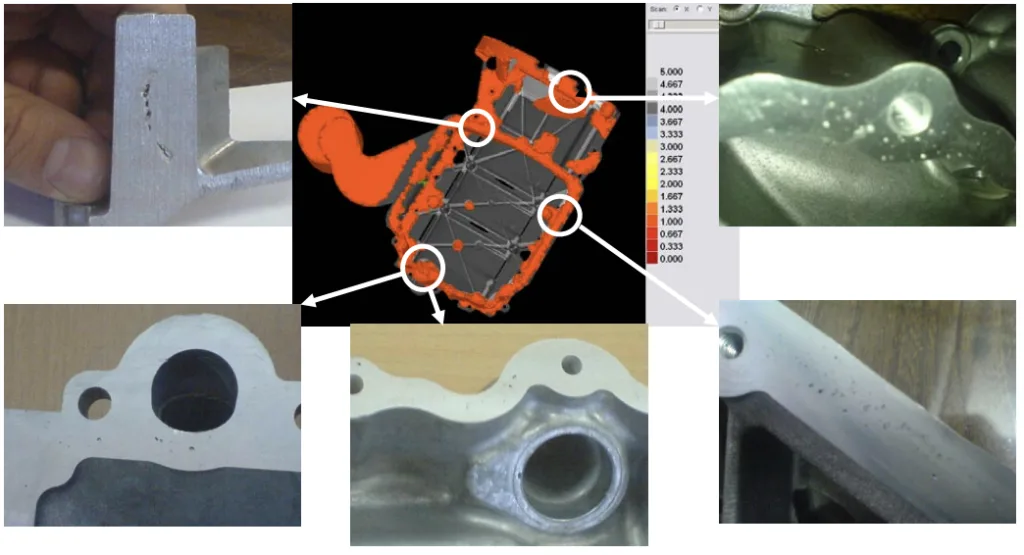
6. Conclusion and Discussion:
- Summary of Main Results: This research successfully utilized numerical simulation with ProCast software to determine the optimal die temperature for high-pressure die casting of an automotive Ladder frame component made of A380 aluminum alloy. The study concluded that die temperatures in the range of 20°C to 25°C are appropriate for this component, while 15°C is insufficient and leads to casting defects. The simulation results were validated by experimental findings, demonstrating good agreement.
- Academic Significance of the Research: The study highlights the effectiveness of numerical simulation as a valuable tool for optimizing die casting process parameters, specifically die temperature. It demonstrates the capability of simulation to predict casting defects and understand the influence of process parameters on melt flow and solidification behavior.
- Practical Implications: The findings provide practical guidance for foundry engineers in optimizing die casting processes. By using simulation tools, engineers can determine appropriate die temperature ranges for specific components and materials, leading to reduced casting defects, improved casting quality, and potentially lower scrap rates and energy consumption.
- Limitations of the Research: The research is limited to a single automotive component (Ladder frame) and A380 aluminum alloy. The study also notes limitations related to the automatic molding system used, which hindered the implementation of a chilling system to address micro-shrinkage.
7. Future Follow-up Research:
- Directions for Follow-up Research: Future research should explore the effects of other critical casting parameters on the quality of die-cast parts. These parameters include:
- Melt superheat
- Pouring time (velocity)
- Mould surface roughness
- Gating design
- Mould configuration
Further investigation into these parameters using simulation can provide a more comprehensive understanding of the die casting process and enable further optimization for improved quality and efficiency.
8. References:
- [1] M. Merlin, G. Timelli, F. Bonollo, G. L. Garagnania” Impact behaviour of A356 alloy for low-pressure die casting automotive wheels” J. Mater. Pro. Tech. Vol. 209 (2009), pp1060-1073.
- [2] M. Dargusch, M. Nave, P.McKinney “Porosity Reduction in a HighPressure Die Casting ThroughThe Use of Squeeze Pins” NADCA (2003), pp405-412.
- [3] J.X. Zhou, L.L. Chen, D.M. Liao, R.X. Liu: J. Mater. Pro. Tech. Vol. 192–193 (2007), pp 249-254.
- [4] Z. Sun, H. Hu, X. Chen: J. Mater. Pro. Tech. Vol. 199 (2008), pp256–264.
- [5] “FAILURES OF DIES FOR DIE-CASTING OF ALUMINIUM ALLOYS”, METABK 47(1) 51-55, 2008.
- [6] A. Kermanpur, Sh. Mahmoudi, A. Hajipour, “Numerical simulation of metal flow and solidification in the multi-cavity casting moulds of automotive components”, J. Mater. Pro. Tech. Vol. 206 (2008), pp62-68.
- [7] D. McBride, T.N. Croft, M. Cross: Computers & Fluids, Vol.37 (2008), pp170–180.
- [8] Z. Brown, C. Barnes, J. Bigelow - Contech U.S., Kalamazoo “Squeeze cast automotive applications and design considerations", 4Th International Conference High Tech Die Casting 9-10 April 2008, Montichiari, Italy.
- [9] V. Ilotte “ Die casting for chassis components" 4Th International Conference High Tech Die Casting 9-10 April 2008, Montichiari Italy.
- [10] G. Timelli, F. Grosselle, F. Voltazza, E. Della Corte “A new reference die for mechanical properties evaluation in diecasting Part 1 - Design and process optimization" 4Th International Conference High Tech Die Casting 9-10 April 2008, Montichiari Italy.
- [11] B.S. Sung, I.S. Kim “The molding analysis of automobile parts using the die-casting system” J. Mater. Pro. Tech. Vol. 201 (2008), pp635–639.
- [12] Z. GUO, S. XIONG, S.H. Cho, J.-K. Choi, “Heat Transfer between Casting and Die during High Pressure Die Casting Process of AM50 Alloy-Modeling and Experimental Results”, J. Mater. Sci. Technol. Vol.24 (2008), pp131-135.
- [13] G. Muneratti “Role, functions and heat transfer of die coating in the aluminum die casting process" 4th International Conference High Tech Die Casting 9-10 April 2008, Montichiari Italy.
- [14] P. J. Pearson, “Contact heat transfer coefficients in aluminum alloy die casting: an experimental and numerical investigation” PhD thesis, Ohio State University, 1994.
9. Copyright:
This material is Mohammad Sadeghi, Jafar Mahmoudi's paper: Based on Numerical determination of process parameters for fabrication of automotive component.
Paper Source: http://urn.kb.se/resolve?urn=urn:nbn:se:mdh:diva-22917
This material was summarized based on the above paper, and unauthorized use for commercial purposes is prohibited.
Copyright © 2025 CASTMAN. All rights reserved.